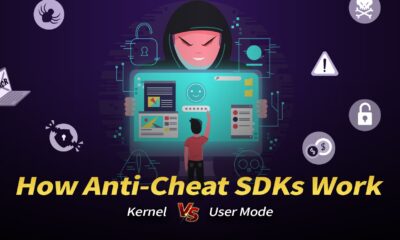Startups
Setting up an Online Business with Custom Software Development
Published
1 year agoon
By
Samuel TingStarting an online business with custom software can be a game-changer, offering flexibility and a unique market edge. However, careful planning is key to success. Below are the steps you need to follow to set up your online business using custom software, from defining your customer to securing funding.
Define Your Customer
Before you dive into development, it’s crucial to define your target audience. The ideal customer profile (ICP) is a representation of your perfect customer, typically described using data such as demographics, buying behavior, and pain points. Start by asking, “Who will benefit the most from my product or service?” The answer will guide your marketing, product design, and overall business strategy.
To describe your ideal customer, you need to understand their challenges and how your software can solve their problems. Break down your customers into different segments based on industry, company size, location, or personal characteristics, such as job role or income. By identifying the common problems or desires within each segment, you can tailor your software features to deliver maximum value. For instance, if your product targets small businesses, emphasize affordability and ease of use. If it’s aimed at large enterprises, scalability and integration options should be your focus. Ultimately, a well-defined ICP helps align your custom software with market demand, increasing the chances of success.
Create a Good Business Plan
Once you’ve defined your customer, the next step is to develop a solid business plan. One way to do this effectively is by using frameworks like the Business Model Canvas or Lean Canvas. These tools help simplify complex business strategies by breaking them down into key components such as value proposition, customer relationships, revenue streams, and cost structures.
A full business model should contain several elements, including a clear description of your target market, a value proposition outlining how your product solves a problem, your revenue model (how you’ll make money), a marketing and sales strategy, and an operations plan that covers the production and delivery of your software. Additionally, consider financial forecasts to ensure that your business will be sustainable over time. If you need guidance on choosing between these two tools, Sailing Byte has a helpful article on Business Model Canvas vs. Lean Canvas.
A well-thought-out business plan acts as a roadmap for your startup, helping you navigate challenges, stay focused on your goals, and communicate your vision clearly to investors and partners.
Creating an MVP
The next step in launching your online business with custom software is developing a Minimum Viable Product (MVP). An MVP is the simplest version of your custom enterprise software that solves a core problem for your target customers. The goal of the MVP is to validate your business idea with real users while minimizing the time and cost involved in development. By focusing on the core functionalities that deliver the most value, you can gather feedback and improve the product iteratively.
Testing your MVP with potential users is critical, and one effective way to do this is through Google Ads. By running targeted ads, you can drive traffic to your MVP landing page and gauge interest based on user engagement, clicks, or sign-ups. This method allows you to test your assumptions about customer needs and validate product-market fit before investing further in development. Not only does this save time and money, but it also ensures you’re building software that your audience actually wants.
Explore Different Funding Options
Once your MVP is validated, it’s time to think about scaling your business. This often requires external funding, and there are several options to consider.
Bootstrapping is the process of funding your business using personal savings or early revenue. The main advantage of bootstrapping is that you retain full ownership and control of the business. However, it can be challenging to grow quickly without outside capital, and the risk is higher if your business fails to generate revenue early on. Bootstrapping requires a lean mindset, focusing on maximizing resources and minimizing costs.
Another option is to find co-founders who can contribute both capital and expertise. Co-founders can help share the burden of running the business and may bring skills or networks you lack. However, finding the right partner can be challenging, and disagreements can arise if you don’t have a shared vision for the company’s future.
You can also consider reaching out to venture capital (VC) firms, which invest in high-potential startups in exchange for equity. VC funding can help you scale quickly, but it often comes with expectations for rapid growth and a long-term exit strategy, such as going public or being acquired. Working with VCs means giving up some control, but the influx of capital can provide the resources needed to dominate your market.
Finally, business angels are individual investors who provide capital to early-stage startups. Unlike VCs, business angels tend to invest smaller amounts and are often more hands-on, offering mentorship and guidance in addition to funding. The downside is that, like VCs, they will expect equity in return and may have significant influence over the direction of the business.
Choosing the right funding path depends on your long-term goals, the amount of capital needed, and your tolerance for risk. Some founders prefer to maintain full control, while others are willing to trade equity for faster growth and external expertise.
Crafting a Strategy for Long-Term Success
Setting up an online business with custom software requires thoughtful planning and execution. By clearly defining your customer, creating a solid business plan, building an MVP in Agile framework with software house, and exploring funding options, you set the foundation for long-term success. Each step is crucial for ensuring that your product resonates with the market, is scalable, and has the financial backing needed to grow.
While custom software can offer tremendous flexibility and differentiation, it’s equally important to balance ambition with practical planning. A well-executed strategy can take your online business from an idea to a thriving enterprise.

How Anti‑Cheat SDKs Work (Kernel vs User Mode)

New 240Hz 1440p Panels: What Changes for Players

From Chaos to Clarity: How Data Lake Zones Organize the Modern Data Stack

The Powerful Benefits of Omega-3 Fish Oil 1000mg for Overall Health

Legal & Regulatory Challenges for Aviator Games Globally

Tropical Travel Guide: Plan Your Perfect Vacation

Esports vs Classic Sports: Where’s the Real Competition?

Frametime vs FPS (2025): Why p95 Wins for Esports

Top 5 Security Challenges in Crypto Payment Development and How to Solve Them





